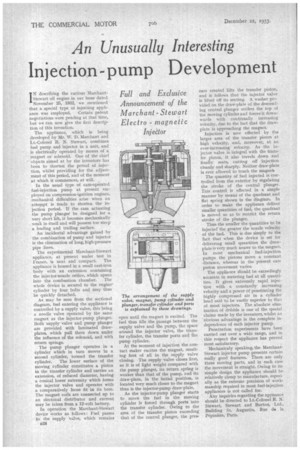An Unusually Interesting
Page 34

If you've noticed an error in this article please click here to report it so we can fix it.
Injection-pump Development
Full and Exclusive Announcement of the MarchantStewart Electro magnetic Injector
IN describing the curious MarChantStewart oil engine in our issue dated November 25, 1932, we mentioned that a special type of injecting appliance was employed. Certain patent negotiations were pending at that time, but we can now give the first description of this invention.
The appliance, which is being developed by Mr. W. D. Marchant and Lt.-Colonel R. N. Stewart, combines fuel pump and injector in a unit, and is electrically operated by means of a magnet or solenoid. One of the chief objects aimed at by the inventors has been to shorten the period of injection, whilst providing for the adjustment of this period, and of the moment at which it commences, at will.
In the usual type of cam-operated fuel-injection pump at present employed on compression-ignition engines, mechanical difficulties arise when an attempt is made to shorten the injection period. If the cam actuating the pump plunger be designed for a very short lift, it becomes mechanically weak in itself and will possess too steep a leading and trailing surface.
An incidental advantage gained by the combination of pump and injector is the elimination of long, high-pressure pipe lines.
The experimental Marchant-Stewart appliance, at present under test in France, is neat and compact. The appliance is housed in a small cast-iron body with an extension containing the injector-nozzle orifice, .which opens into the combustion chamber. The whole device is secured to the engine' cylinder by four bolts and may thus be quickly detached.
As may be seen from the sectional diagram, fuel entering the appliance is controlled by a supply valve, this being a needle valve operated by the same magnet as the injector-pump plunger. Both supply valve and pump plunger are provided with laminated draw. plates, which pull them down under the influence of the solenoid, and with return springs.
The pump plunger operates in a cylinder which in turn moves in a second cylinder, termed the transfer cylinder. The lower surface of the moving cylinder constitutes a piston in the transfer cylinder and carries an extension, of reduced diameter, having a conical lower extremity which forms the injector valve and operates with a comparatively loose fit in its bore. The magnet coils are connected up to an electrical distributor and current may be taken from a 12-volt battery.
In operation the Marchant-Stewart device works as follows: Fuel passes to the supply valve, which remains B28 open until the magnet is excited. The fuel thus fills the passage between the supply valve and the pump, the space around the injector valve, the transfer cylinder, the transfer ports and the pump cylinder.
At the moment of injection the contact maker excites the magnet, resulting first of all in the supply valve closing. The supply valve closes first, as it is of light weight compared with the pump plunger, its return spring is weaker than that of the pump, and its draw-plate, in the initial position, is located very much closer to the magnet than is the injector-pump draw-plate.
As the injector-pump plunger starts to move the fuel in the moving cylinder is forced through ports into the transfer cylinder. Owing to the area of the transfer piston exceeding that of the central plunger, the pres sure created lifts the transfer piston, and it follows that the injector valve is lifted off its seating. A washer provided on the draw-plate of the descending central plunger strikes the top of the moving cylinder and forces it downwards with continually increasing velocity, due to the fact that the drawplate is approaching the magnet.
Injection is now effected by the larger area of the transfer piston at high velocity, -and, moreover, at an ever-increasing velocity. As the injector valve is integral with the transfer piston, it also travels down and finally seats, cutting off injection cleanly and sharply. Neither draw-plate is ever allowed to touch the magnets The quantity of fuel injected is controlled from the exterior by regulating the stroke of the central plunger. This control is effected in a simple manner by means of the quadrant and fiat spring shown in the diagram. In order to make the appliance deliver smaller quantities of fuel, the quadrant is moved so as to restrict the return stroke of the plunger.
Thus the smaller the quantities to be injected the greater the nozzle velocity of the fuel. This is due simply to the fact that when the device is set for delivering small quantities the drawplate is very much nearer to the magnet. In most mechanical fuel-injection pumps the pistons move a constant distance, whereas in the present case piston movement varies.
The appliance should be exceedingly accurate in metering fuel at all quantities. It gives extremely rapid injection with a constantly increasing velocity and a power of penetrating the highly compressed air in a cylinder head said to be vastly superior to that of most injectors. The absolute elimination of dribble is one of the special claims made by the inventors, whilst an obvious advantage is the complete independence of each injector pump.
Penetration experiments have been carried out over a wide range, and in this respect the appliance has proved most satisfactory.
Mechanicaly speaking, the MarchantStewart injector pump presents certain really good features. There are only three moving parts, and in each case the movement is straight. Owing to its simple design the appliance should be relatively cheap to manufacture, especially as the extreme precision of workmanship required in most fuel-injection appliances is not called for.
Any inquiries regarding the apptiance should be directed to Lt.-Colonel R. N. Stewart, Stewart and Burton, 'Ltd., Building St. Augustin, Rue de la Pepinierei Paris.












































































